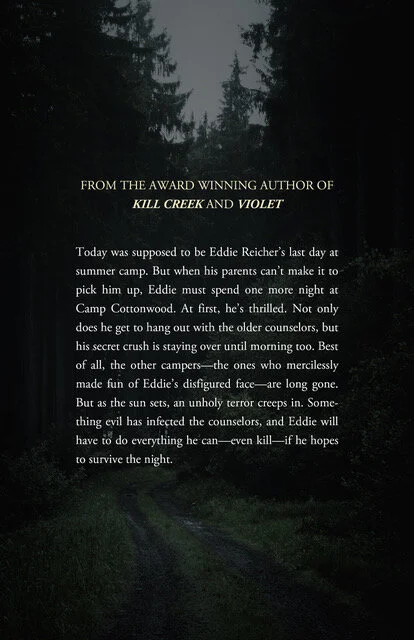We had the honor of first speaking with horror author Scott Thomas at the end of 2019 in episode 44 of the podcast. In that episode, we talked a lot about Scott’s experience with writing his signature slow burn horror fiction in the novels Kill Creek and Violet. Each of these books revealed his intimate understand of the horror genre, as well his unique ability to flip trope and defy convention. His novella The Boy in the Woods, while different in form and structure, is written in Scott’s signature empathetic style. I loved this heartbreaking rush of a book. It offers the nostalgia many horror fans crave, while also flipping expectation and evolving the genre. Which is, in my humble estimation, what good horror fiction is all about.
I was delighted to have the opportunity to welcome Scott back to Ladies of the Fright in written form.
Lisa Quigley | Ladies of the Fright: We last spoke toward the end of 2019. It almost feels like another lifetime! Tell us how you’re doing. And although this is sure to be a loaded question, what’s new for you since we last spoke on the podcast?
Scott Thomas: Well, that whole 2020 thing happened, so there’s that. But professionally, I spent most of the past year writing and showrunning a series for Syfy based on George A. Romero’s Day of the Dead. I spent four months up in Vancouver shooting it. We reimagined the characters and expanded the world to show what might happen during a living dead invasion that could lead to the situation we see in Romero’s movie. It’s scary, gory, a little over-the-top and a lot of fun. I also worked on some short stories and novellas, including The Boy in the Woods. And I have a few screenplays in the works.
LQ | LOTF: The novella The Boy in the Woods is your latest project. Tell us more about what made you want to write it?
ST: It was an idea I’d had for a long time, but it all kind of fell into place last year. I wanted to write a flip on ‘80s camp slasher movies where the counselors are the bad guys and the weird outcast camper is the hero.
LQ | LOTF: There seems to be a “boom” in the horror novella as of late. What is it you like about the form?
ST: I really enjoy writing novels and getting lost in the expansive world and the tangents that novels allow, but novellas are a lot of fun to tell a fast, lean, mean story that goes off like a rocket. I have several ideas that I don’t think are quite big enough for a novel, so the novella form is perfect for those projects that fall somewhere in the middle.
LQ | LOTF: How was your experience writing a novella vs. writing a novel? Did you find there were any freedoms? Any limitations?
ST: After writing Violet, which is a very slow-burn supernatural novel, I wanted to write something with very little setup before the action kicks in. I wasn’t sure how long The Boy in the Woods would be; I just knew that I wanted it to be as lean as possible and only tell the story of what was happening at the camp. When I finished it, I knew it was much too long to be thought of as a “short story,” so it fell into that middle ground of “novella.” There was definitely freedom in not feeling like I had to take my sweet time building a slow burn story like Kill Creek or Violet. I could just set up the characters and let the shit hit the fan. I didn’t really feel any limitations while writing it because I knew I wasn’t telling a novel-length story. I was only limited by the amount of story I chose to tell.
LQ | LOTF: There is a lot that is familiar about The Boy in the Woods: summer camp, slasher vibe, outsider kid, etc. At the same time, you’ve managed to take these tropes and do something altogether new. Tell us more about how these different pieces came together for you.
ST: I grew up in the ‘80s, so most of my horror consumption at that time was slasher films. I loved supernatural horror like The Shining, The Amityville Horror, The Changeling, The Omen, but I really loved slasher movies. Halloween, Friday the 13th, A Nightmare on Elm Street, Madman, The Burning, Sleepaway Camp, Tourist Trap, Terror Train, My Bloody Valentine, Slaughterhouse—there are too many to name. You could always go to the video store and find a badass slasher movie for a Saturday night. That was the era of the horror anti-hero where Jason and Michael and Freddy were the stars of the show. For as long as I can remember, I had this vague idea of turning the slasher story on its head and making the counselors the threat so the campers would have to kill them to survive. The pieces really didn’t start to come together until I came up with the character of Eddie. Once I really knew who he was, the last line of the story popped into my head and I knew it was finally time to write it.
LQ | LOTF: That ending though—my heart! I won’t spoil, especially since this is a novella and I want readers to stay as surprised as possible. But I will say...moments before it happened, I realized where it was going and my heart sank. Like I said, we don’t want to spoil, but I am curious, but I would love to hear your thoughts on crafting compelling endings.
ST: I almost never start writing a story or script until I’m positive about the ending. Things can change along the way, but the ending almost always stays the same. I have to know my destination before I can start on the journey. Kill Creek was that way, although the epilogue changed drastically while working with an editor at Inkshares. Originally there was a completely different epilogue. Violet always had that ending, although the very last line didn’t come to me until I wrote it. For The Boy in the Woods, I knew the last line from the beginning. A lot of the tragic things that happened along the way were pleasant—if you can call them “pleasant”—surprises for me. But I always knew where it was going. I want an ending to be satisfying for the reader, but since this is horror, I want to leave them with something haunting, something a bit open-ended that hits them in the gut and the heart. Character and emotion are very important to me when I tell a story. I want the horror to be visceral but also emotional. When I came up with the character of Eddie, I realized the exact story I was telling and that it could be more than just a meta take on slasher horror. I had tried writing some version of The Boy in the Woods before, but it wasn’t until I knew who Eddie was and I had that last line that I felt I finally had the whole story in my head.
LQ | LOTF: I think making the main character a boy who’s been previously maimed by a dog was a bold choice, because it had the potential to really veer into insensitive territory. I think the way you avoid doing this is really allowing us to connect with Eddie on a personal level, and after reading it, I definitely see it as an indictment against “ableism” and the ways our society rejects anyone who’s “different.” Can you talk more about this and shed some light on your choices in how you characterized Eddie?
ST: Whenever I’m writing a character with a different life experience than me, I try to be as careful as I can to make it feel authentic and not exploitative. I’m not always 100% successful, but the intention is always there. You never know how a reader will react until you write something and put it out into the world, but if I expect the reader to care about my characters, I have to care about them. I have to love them for everything they are. I’ve learned a lot as a writer from reader reactions to Kill Creek and Violet. I try to read every comment and review and I take it all to heart. For The Boy in the Woods, I knew I was telling a reverse slasher story, and in those ‘80s movies, the villain always had something about them that made them different, an outsider. Leatherface apparently had the mentality of a child, Jason had some sort of physical deformity, Freddy and Cropsy were both horribly burned, Angela had her own secret. So I wanted our hero to be an outsider like them, but I also wanted to understand how the torment he experienced felt, how awful that must have been to be Jason going to summer camp and being bullied by the other kids and pitied or ignored by the counselors. When I started to explore that, I realized how misunderstood someone like Jason is—a kid who is picked on, who is left to drown by the counselors, who sees his mother murdered—he’s really a sympathetic character. He’s not even allowed to rest in peace once Tommy sticks a lightning rod in his corpse in Part 6. So for The Boy in the Woods, I wanted to start there, with a kid who is “different,” who doesn’t look like the other kids, and to really see the story from his point of view. I wanted to show that once you get past the scars, he’s no different from any other kid. He has the same hopes and fears, the same insecurities and moments of triumph. He’s a great kid, and the bullies can go to hell.
LQ | LOTF: What else would you like to share about ‘the making of’ The Boy in the Woods?
ST: I started writing it while in pre-production for Day of the Dead and finished it while in quarantine up in Canada. It was a great way to escape the isolation of quarantine, and I hope it’s a fun but wicked escape for readers.
LQ | LOTF: Do you have any new upcoming projects you’d like to discuss?
ST: In addition to the Day of the Dead series which will premiere sometime in 2021, I’m working on several short stories/novellas in hopes of putting out a collection this year. I also have some big screen projects in the works that I can hopefully announce soon.
LQ | LOTF: Remind our audience where they can find you:
ST: You can find me on Facebook on my official page @scottthomaswriteshorror. On Instagram @officialscottthomas. On Twitter @ninjawhenever. Kill Creek and Violet are available wherever books are sold. And The Boy in the Woods is available as an ebook exclusively at Inkshares.com.
Scott Thomas is the Stoker Nominated Author of KILL CREEK and VIOLET. He is also the creator/EP of RC9GN, Best Friends Whenever, Raven's Home, Malibu Rescue and Syfy’s Day of the Dead.
Disclosure: We are affiliates of Bookshop.org and will earn a commission if you click through and make a purchase. Support indie bookstores; support authors; support the show. Win/win/win!


